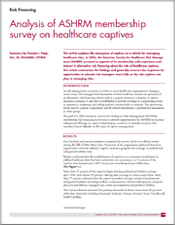Resource:
Analysis of ASHRM Membership Survey on Health Care Captives
This article summarizes the responses for opportunities to educate risk managers more fully on the role captives can play in managing risks.
In 2006, the American Society for Healthcare Risk Management (ASHRM) surveyed a segment of its membership with experience and interest in alternative risk financing about the role of healthcare captives. This article summarizes the findings and generally assesses the responses for opportunities to educate risk managers more fully on the role captives can play in managing risks.
Introduction
As risk management continues to evolve to meet health care organizations’ changing needs, many risk managers find themselves involved with the creation or operation of an alternative risk financing vehicle such as a captive insurance company. A captive insurance company is one that is established to provide coverage to a sponsoring entity as opposed to marketing and selling policies commercially to insureds. The sponsoring entity may be a parent corporation and its related subsidiaries, a professional association or other group.
The goal of a 2006 American Society for Healthcare Risk Management (ASHRM) membership risk financing survey was to identify opportunities for ASHRM to increase educational offerings on captive related topics, as well as to identify resources that members found valuable on the topic of captive management.
Results
One hundred and sixteen members completed the survey, which was offered online during the fall of 2006. More than 78 percent of the respondents indicated that their organization currently utilized a captive insurance program for coverage in professional and general liability risks.
Results confirmed that the establishment of captives as an insurance mechanism to address healthcare risks has been a relatively new occurrence, as 74 percent of the captives were formed since 1997; 66 percent were formed since 2000 alone.
More than 70 percent of the captives began writing professional liability coverage after 1999, with almost 95 percent offering that coverage in claims-made form. More than 75 percent indicated that the captive provided coverage outside of professional and general liability, including workers’ compensation, clinical trial exposure, property, directors and officers, managed care, errors and omissions and products liability. The Cayman Islands remained the primary domicile of choice (more than 50 percent) with other domiciles including Bermuda, Vermont, Hawaii, Arizona, Texas, Nevada and South Carolina.
Download the full article to learn more.

